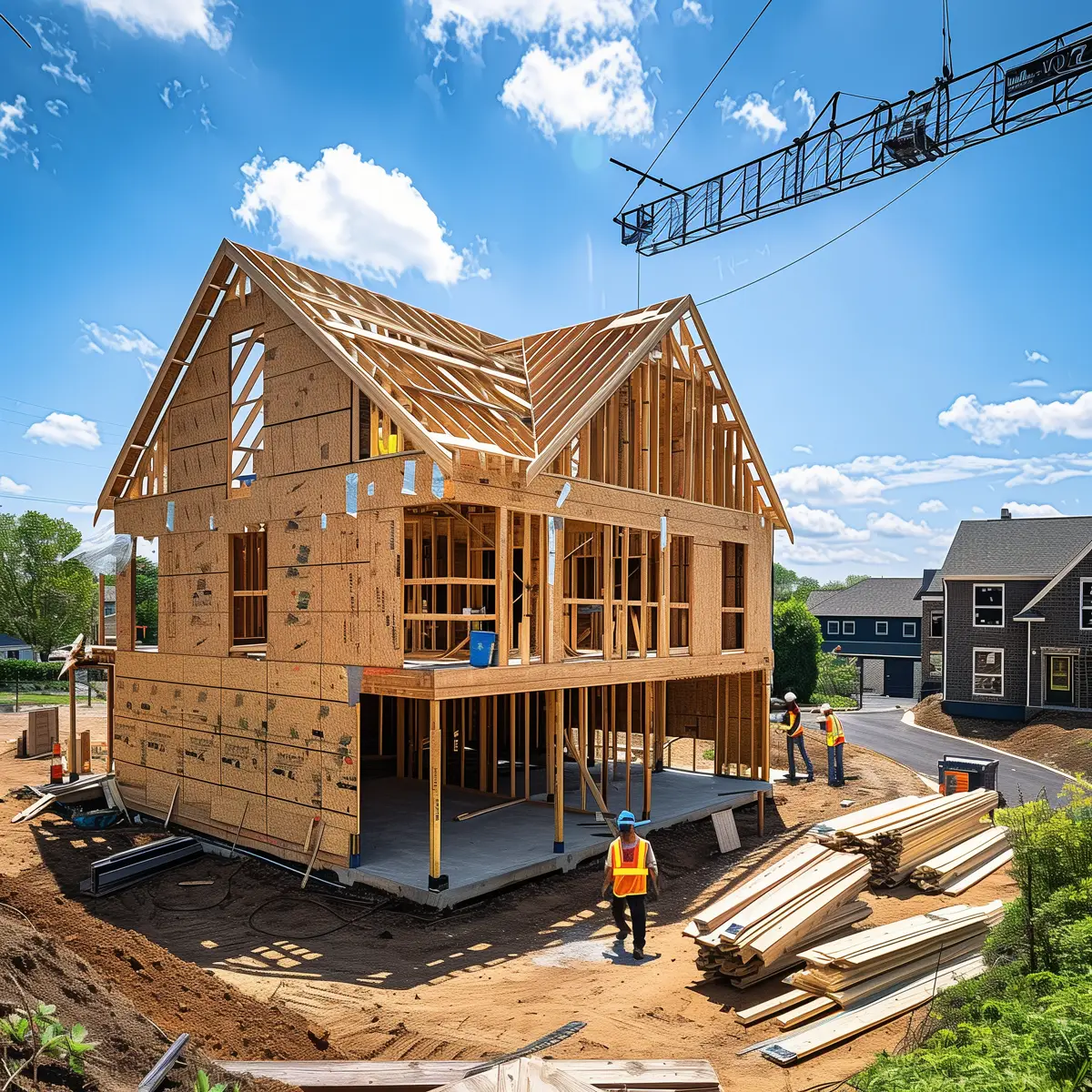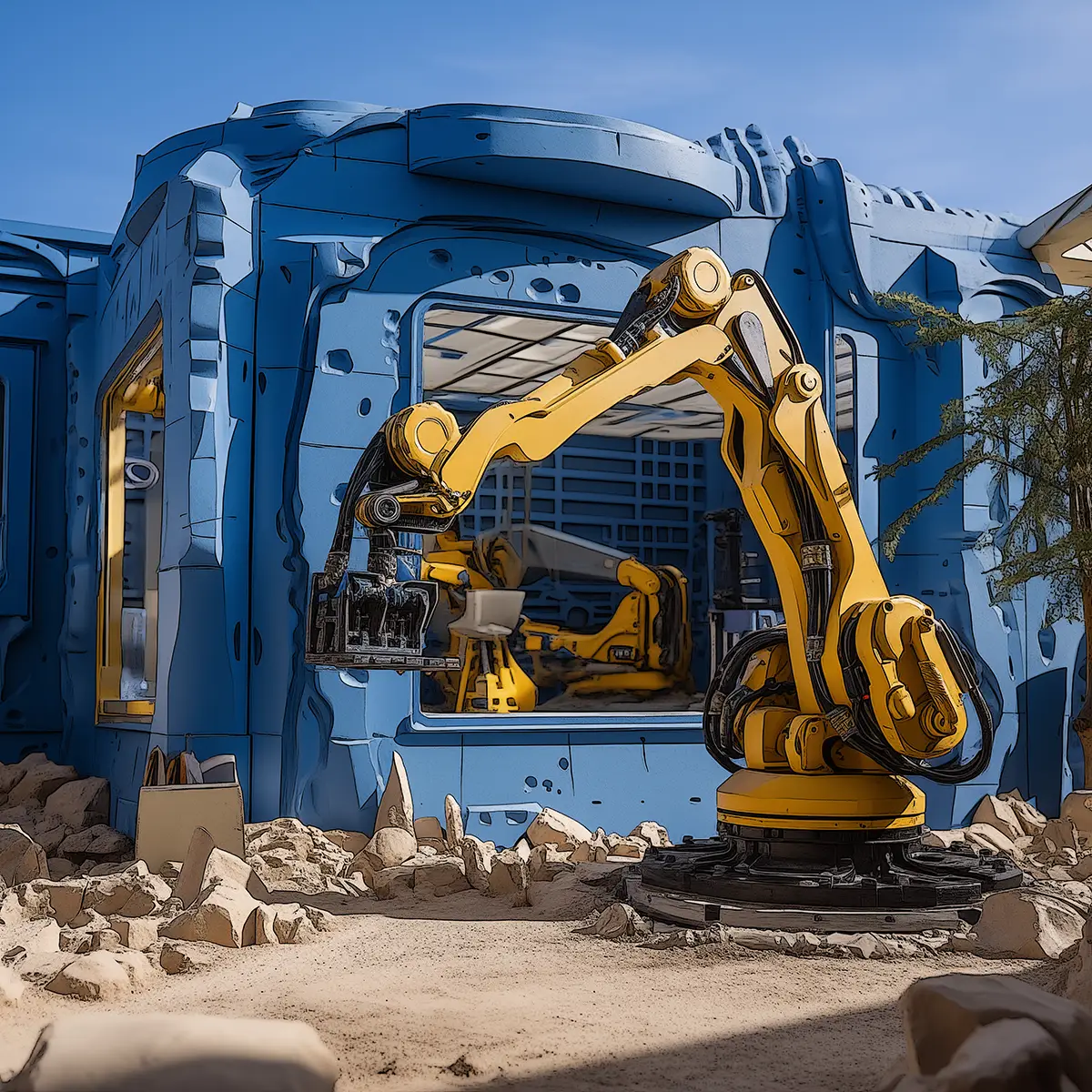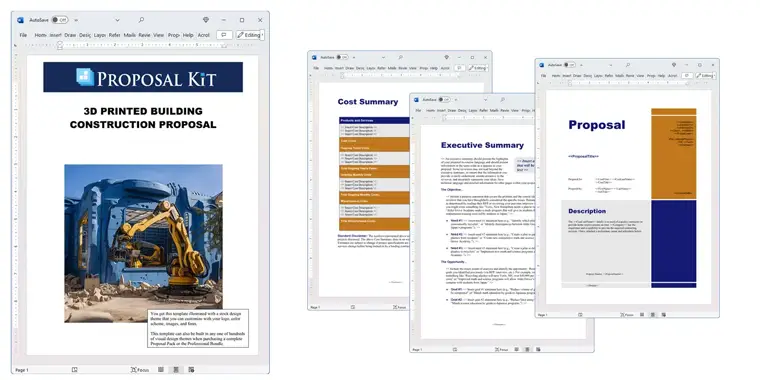How to write your 3D Printed Building Construction Proposal
We include this 21 page layout with every Proposal Pack. If you want this template to have a different visual design theme than the one illustrated here, purchase any Proposal Pack design and create this template using the purchased design theme. This template is included in every Proposal Pack. If you get a Proposal Pack or the Professional, you can also make any variation of this template with different chapters to suit your needs.
We typically include more chapters in the templates than most people will need to give everyone more variety in the chapters they may need. You can trim down a long template by removing pages you do not need or combining multiple chapter topics into one page.
 DOWNLOADABLE, ONE-TIME COST, NO SUBSCRIPTION FEES
DOWNLOADABLE, ONE-TIME COST, NO SUBSCRIPTION FEESYou can also create countless variations of this document to suit your needs using the included library of 2200+ chapters if ordering a Proposal Pack or Professional.
 What Our Clients Say
What Our Clients SayThank you!! Everyone at our national headquarters (Kinko’s, too) wanted to know "who" did the business proposal layout. I told them proposalkit.com! I don’t know what I would have done without Proposal Kit. I had a massive brain freeze and couldn’t design my way out of a clear plastic bag."
American Red Cross of Florida
Related Article
Related Video
Related Templates
- Home Construction Proposal
- Construction Project Proposal (Short)
- Civil Engineering Construction Project Proposal
- Energy Efficiency Proposal
- 3D Printing and Prototyping Services Proposal
- Energy Efficiency Grant Project Proposal
- Custom Home Building Proposal
- Concrete Cutting Services Proposal
- Glass and Glazing Contractor Proposal
- 3D Printing Services Proposal Template
What's the best way to write your 3D-printed building construction proposal?
A proven solution to create an effective construction proposal is using the Proposal Kit template and software package. This system offers a wide variety of template options. It integrates a line item quoting database for detailed cost summaries, quotes, estimates, budgets, and other financial calculations, making it a comprehensive tool for your proposal needs.
Are you tasked with writing a proposal for a 3D-printed building project and feeling overwhelmed? Proposal Kit can simplify this process for you.
What Types of Projects Are 3D-Printed Building Construction Proposals Written For?
3D-printed building construction can vary widely, depending on the specific needs and goals of the project. Here are some different examples:
- Residential homes
- Commercial buildings
- Emergency disaster relief shelters
- Affordable housing solutions
- Custom-designed architectural structures
- Landscape features and outdoor structures
- Infrastructure elements like bridges and roads
- Educational facilities and campuses
- Medical clinics and hospitals
- Art installations and sculptures
- Modular units and prefabricated components
- Renovation projects for historical preservation
- Sports and recreational facilities
- Research and development centers
- Transportation hubs such as bus and train stations
- Environmental conservation projects
- Military and defense structures
- Retail spaces and shopping centers
- Office buildings and corporate headquarters
- Community centers and public gathering spots
Chapters this template is built with
When writing a construction proposal, remember that no single template fits all scenarios. Proposal Kit enables you to generate custom proposals with its software and extensive library of thousands of templates. Here's how you can use specific chapters from the Proposal Kit to address various aspects of your construction proposal.
Cover Letter
Introduce your proposal and establish a personal connection with the client, setting the stage for the detailed documents to follow. Mention the innovative nature of 3D printing technology and briefly touch on the benefits, such as cost savings and speed.
Title Page
The front page of your proposal includes the project title, company name, and the date. This page sets a professional tone and provides important project identification.
Table of Contents
A straightforward guide to the organization of your proposal, making navigation easy for the reader. Ensure that each section listed corresponds to the critical parts of your proposal, allowing clients to find the information they need quickly.
What You Can Expect
Outline the project phases and what the client should expect during each construction process step. Discuss how the innovative 3D printing processes will be integrated into traditional construction phases, providing a roadmap from design to completion.
3-D Printing
Discuss the specific technologies and processes involved in 3D printing for the project. Highlight the particular 3D printing equipment and software used and the advantages over traditional construction methods.
Materials
Detail the materials used for 3D printing, emphasizing sustainability and efficiency. Describe specific composite materials or recycled substances that enhance the eco-friendly aspect of the project.
Eco-Friendly
Highlight the environmental benefits of 3D printing in construction, such as reduced waste and energy consumption. Discuss how the project will contribute to sustainability goals, including using biodegradable materials and minimizing the carbon footprint.
Permits and Licenses
Explain the permits and licenses required for the project and how you will secure them. Include any special permits unique to 3D printed construction, demonstrating your expertise in navigating regulatory requirements.
Site Preparation
Describe the initial steps to prepare the construction site for 3D printing. Detail the unique requirements for setting up a 3D printing operation, such as leveling the ground and ensuring proper access to machinery.
Construction Schedule
Provide a timeline for the project, outlining key milestones and completion dates. Highlight how 3D printing can accelerate certain project phases, offering a more efficient schedule than traditional construction methods.
Electrical
Detail the planning and installation of electrical systems within the 3D printed structure. Discuss how electrical conduits will be integrated into the 3D printing process, ensuring seamless incorporation into the final build.
Plumbing
Discuss the integration of plumbing systems and any innovative solutions provided. Explain how plumbing pathways will be pre-planned and incorporated into the 3D-printed walls, reducing the need for retrofitting.
Roofing
Explain the roofing solutions suitable for 3D printed buildings and their benefits. Discuss how 3D printing allows for unique and efficient roofing designs with better insulation and durability.
Landscaping
Propose landscaping ideas that complement the architecture and enhance the property. Mention how the precise control of 3D printing allows for creating custom landscape features, such as garden walls and seating areas.
Building Codes
Ensure compliance with local building codes and regulations, demonstrating your knowledge and adherence. Explain how 3D printed structures will meet or exceed these codes, addressing potential concerns about new technology.
Cost/Benefit Analysis
Present a detailed analysis of the costs versus expected benefits, helping the client understand the value. Highlight specific cost savings from reduced labor, material efficiency, and shortened construction timelines.
Cost Summary
A detailed financial overview of the project, leveraging the line item database to ensure accuracy. Provide a transparent breakdown of costs, clearly showing how each aspect of the 3D printed construction contributes to the overall budget.
Company History
Share your company's history and background to build credibility and trust. Emphasize any previous experience with 3D printing projects, demonstrating your expertise and track record of success.
Certifications
List relevant certifications that demonstrate your expertise in 3D printed construction. Include any specialized training or industry-recognized credentials supporting your project execution capability.
Testimonials
Include client testimonials to prove your company's competence and reliability. Choose testimonials that specifically mention the advantages of 3D printed construction, reinforcing the benefits discussed in your proposal.
Back Page
Conclude the proposal with any final remarks or calls to action, inviting the client to proceed with the project. Thank the client for their consideration and provide clear contact information for follow-up questions and next steps.
Use cases for this template
Transforming Residential Construction with Innovative 3D Printing
Alice, a small business owner at InnovaBuild LLC, was excited about pitching for a new residential housing project. The project involved using advanced 3D printing technologies to create affordable homes rapidly. Although Alice had a solid understanding of 3D printing, she lacked experience developing a comprehensive proposal to communicate her vision to potential clients.
Alice turned to the Proposal Kit. She used its extensive template library to create a proposal. The 3D Printing and Materials chapters give her details on cutting-edge technology and sustainable materials she would use. The Cost Summary template helped her present a clear and detailed financial plan, showcasing the cost-efficiency of her approach compared to traditional building methods.
By incorporating the What You Can Expect chapter, Alice could outline the project phases and set clear expectations for her clients. The Testimonials section added authenticity, featuring satisfied customers who had previously benefited from her innovative methods. The Eco-Friendly chapter highlighted the environmental advantages of 3D printing, making her proposal even more appealing.
Thanks to the Proposal Kit, Alice's proposal was comprehensive and persuasive. She successfully secured the contract, paving the way for InnovaBuild LLC to lead the innovative residential construction market.
Rapid Response to a Commercial Project Deadline
John, an employee at QuickStructures Inc., was in a challenging situation. His company had just been invited to bid on a large commercial building project, but the deadline was extremely tight. John knew a well-detailed proposal was crucial to standing out, but time was not on his side.
Faced with this pressure, John turned to Proposal Kit for a solution. The software's extensive array of customizable templates allowed him to find what he needed quickly. To expedite the writing process, he employed an AI writing tool. By prompting the AI to analyze his company's website, John generated accurate and relevant content for the proposal.
The Construction Schedule chapter enabled him to present a detailed timeline, addressing potential client concerns about project duration. The Building Codes section reassured the client that QuickStructures Inc. would adhere to all necessary regulations. The Cost/Benefit Analysis provided a clear financial argument, demonstrating how the project would be a valuable investment.
By integrating the AI-generated content with the Proposal Kit templates, John quickly produced a polished and professional proposal. His rapid response and comprehensive proposal impressed the client, leading to a successful bid for QuickStructures Inc.
Non-Profit Organization Seeking Sustainable Building Solutions
Sara, a director at EcoConstructs, was tasked with writing an RFP for a new community center. The project aimed to use sustainable 3D printing techniques to create an eco-friendly facility. Sara needed to detail every aspect clearly to attract capable contractors who shared her sustainability vision.
Turning to the Proposal Kit, Sara found the tools she needed to create an in-depth RFP. She used the Eco-Friendly chapter to emphasize the project's environmental benefits, which were a core value for EcoConstructs. The Materials section allowed her to specify the sustainable materials required, ensuring that contractors understood the project's green goals.
The Permits and Licenses chapter demonstrated Sara's awareness of the regulatory aspects, assuring potential contractors that the project would comply with all legal requirements. The Site Preparation and Construction Schedule chapters provided a detailed roadmap for the project, making it easier for contractors to plan their bids.
By using the Proposal Kit, Sara created a clear and comprehensive RFP that outlined all project requirements and goals. This thorough approach attracted several high-quality bids, allowing EcoConstructs to select the best contractor for their sustainable community center project.
Conclusions and Recommendations
Proposal Kit can dramatically simplify the process of writing a construction proposal. From providing customizable templates and a robust quoting system to offering extensive support materials, Proposal Kit ensures you can efficiently produce professional and persuasive proposals. Proposal Kit has the tools to address your specific needs and help you win the contracts you desire.
Also Known As
This template may also be referred to in different ways or be used in more specialized situations, such as:
- 3D Printed Building Proposal
- Three-Dimensional Printing Construction Proposal
- Additive Manufacturing Building Project Proposal
- Custom Home Building with 3D Printing Proposal
- Sustainable 3D Printed Construction Proposal
- Innovative Construction Techniques Proposal
- Automated Building Fabrication Proposal
- Rapid Prototyping for Building Construction Proposal
- Eco-Friendly Construction Proposal Using 3D Printing
- Modern Construction Proposal with Additive Manufacturing
Abstract
 Over recent years, the construction industry has witnessed significant innovations, particularly with the introduction of 3D construction printing technology. Construction companies are increasingly interested in this technology to revolutionize the way building structures are constructed. Using 3D printers, they can develop complex building elements such as concrete walls, floors, and roofs through a fabrication process that deposits material in layers.
Over recent years, the construction industry has witnessed significant innovations, particularly with the introduction of 3D construction printing technology. Construction companies are increasingly interested in this technology to revolutionize the way building structures are constructed. Using 3D printers, they can develop complex building elements such as concrete walls, floors, and roofs through a fabrication process that deposits material in layers.
This method offers numerous advantages over conventional construction. It addresses labor shortages of skilled workers by relying on automation, reducing the need for extensive manual labor. Architects and designers can now achieve intricate designs with greater freedom, enabling the creation of complex shapes and forms that were previously difficult to construct. Portland cement mixtures extruded through a nozzle allow for precise deposition of materials, resulting in durable and stable structures.
However, there are essential factors to consider. Building codes and standards set by organizations like the International Code Council need to be updated to include provisions for this new technology. Fire performance, thermal insulation, and indoor air quality are critical aspects that must be evaluated to ensure the safety and well-being of occupants. Insurance coverage and legal considerations, including case law and attorney-client relationships, play a crucial role in the adoption of 3D printing construction.
-1200.webp) Companies like Apis Cor have developed gantry systems capable of constructing a 3D printed house in as little as two days. These machines can build structures of a certain height and width, laying down layers of concrete to form walls and other building components. Despite potential defects, malfunctions, and the need for specialized equipment, the technology shows promise in mitigating risks associated with traditional construction methods.
Companies like Apis Cor have developed gantry systems capable of constructing a 3D printed house in as little as two days. These machines can build structures of a certain height and width, laying down layers of concrete to form walls and other building components. Despite potential defects, malfunctions, and the need for specialized equipment, the technology shows promise in mitigating risks associated with traditional construction methods.
The adoption of 3D construction printing is not without its challenges. Businesses must manage the integration of this technology into existing workflows, maintain compliance with regulations, and ensure that employees are trained to operate new machinery. Additionally, considerations around piping, electrical installations, and other building elements must be addressed to ensure seamless integration.
Educational institutions like community colleges are beginning to incorporate this technology into their programs, preparing young people for future roles in the industry. This aligns with the industry's need to resolve the shortage of skilled workers and to stay at the forefront of technological advancement.
 While there are limitations and challenges to overcome, including updates to code compliance and addressing legal and insurance claims, the future of 3D printed building construction holds great potential. It offers the possibility to revolutionize the construction industry by providing faster, more cost-effective, and innovative building solutions. As more construction projects begin to incorporate this technology, it's clear that 3D construction printing will play a significant role in shaping the built environment in the coming years.
While there are limitations and challenges to overcome, including updates to code compliance and addressing legal and insurance claims, the future of 3D printed building construction holds great potential. It offers the possibility to revolutionize the construction industry by providing faster, more cost-effective, and innovative building solutions. As more construction projects begin to incorporate this technology, it's clear that 3D construction printing will play a significant role in shaping the built environment in the coming years.
Frequently Asked Questions
What should I include about 3D printing technology in my proposal?
When writing a proposal for a 3D-printed building construction project, you must provide a comprehensive overview of the specific 3D printing technology you plan to use. Detail how this technology works, its advantages over traditional construction methods, and any unique features that will benefit the project. Discuss the types of printers involved, the materials used, and any special techniques to enhance the project's efficiency and quality. This information will help your client understand the innovative approach you're bringing to the table.
How can I demonstrate the cost-effectiveness of 3D-printed construction in my proposal?
To demonstrate cost-effectiveness, include a detailed Cost Summary chapter in your proposal. Break down all anticipated expenses, such as materials, labor, and equipment, and compare them to traditional construction costs. Highlight areas where 3D printing offers significant savings, such as reduced labor costs and minimized waste. Including a Cost/Benefit Analysis can further justify the investment by showing long-term savings, faster project completion times, and potential tax incentives for sustainable building practices.
What details are crucial for the Site Preparation chapter?
The Site Preparation chapter should address all preliminary steps needed to ready the construction site for 3D printing. Explain how you will evaluate the site conditions, perform necessary land surveys, and make any terrain adjustments required for optimal printer performance. Discuss any groundwork that needs to be completed before printing can commence, such as laying foundations or installing temporary utilities. This chapter reassures the client that you have thoroughly planned for a smooth startup phase, minimizing potential delays and issues.
How should I handle permits and licenses in the proposal?
In the Permits and Licenses chapter, outline the regulatory landscape for your 3D-printed construction project. Specify the required types of permits and licenses, such as building permits, zoning approvals, and environmental clearances. Detail your process for securing these permits, including timelines and responsible parties. Highlight your experience in navigating local regulations, which will instill confidence in your ability to ensure compliance and avoid legal complications that could delay the project.
Can I customize the Proposal Kit templates to fit my project needs?
Yes, the Proposal Kit is designed to be highly customizable, allowing you to tailor each template to meet the unique requirements of your 3D-printed building construction project. Add, remove, or modify chapters to align with your project's specifics. The extensive library of thousands of templates provides a starting point, ensuring you cover all necessary aspects, from technical details and financial summaries to environmental impacts and client testimonials. This flexibility enables you to create a thorough, professional, and compelling proposal.
20% Off Discount
![]() Add To Cart This Word Template
Add To Cart This Word Template
 Add To Cart Proposal Pack for Any Business
Add To Cart Proposal Pack for Any Business
 Add To Cart Proposal Kit Professional
Add To Cart Proposal Kit Professional
 4.7 stars, based on 849 reviews
4.7 stars, based on 849 reviewsProposal Kit chapters used in this template
Cover Letter, Title Page, Table of Contents, What You Can Expect, 3-D Printing, Materials, Eco-Friendly, Permits and Licenses, Site Preparation, Construction Schedule, Electrical, Plumbing, Roofing, Landscaping, Building Codes, Cost/Benefit Analysis, Cost Summary, Company History, Certifications, Testimonials, Back Page
Line Item Automated Chapters
If you purchase a Proposal Pack or the Professional Bundle, these proposal pages are generated using an automated line-item database in the included Wizard software.
Cost Summary, Construction Schedule, Cost Benefit Analysis
You use this proposal for
- General business proposal
- Non-technical proposal
- Service sales proposal
- Project pitch proposal
- Construction, contracting, building proposal
- Real estate, property proposal
How to create this template with Proposal Pack Wizard
You can create this document using any of the logo-designed Proposal Packs. Pick any Proposal Pack with a logo design theme you like best; they will all work equally well. The Proposal Pack for Any Business is the pack with no extra added logos or colors - designed to be used plain or for you to customize with your logos and graphics.
The Proposal Pack design theme you purchase will determine the visual look of this template. The screenshot above only shows the plain generic design theme.
We include a library of chapters to be assembled based on your needs. All proposals are different and have different needs and goals. We designed Proposal Pack so you can customize the documents to suit your needs.
You will best create this document using the Proposal Pack Wizard - Expert Edition software to select this template and build it in the Proposal Pack logo design theme of your choice along with any desired customizations (such as adding additional chapters, removing unneeded chapters, changing the order of chapters, and importing your company logo). This template outlines a proposal for the described situation. Each user is responsible for typing in the actual content of the provided pages with their information to complete the proposal. Suggestions in the abstract may include features in higher-end packages and are facilitated by the selection of chapter templates to support the narrative of each proposal, which help guide the user in filling in the details.
The Wizard software's AI Writer will write the content of the pages of the template based on details provided for your company, client, project, financial details and other writing instructions. This will provide a personalized version of the template completely written and ready to edit.
Once finished, the AI Writer's Word-to-PowerPoint converter can transform your proposal, business plan, or other business documents into a PowerPoint slideshow. Save time and effort by letting the AI analyze every chapter to condense its content into talking points, visually matching the document, and providing a consistent package of presentation material with the click of a button.
You create this template using the Wizard software with an entire Proposal Pack library and software. We include the Expert Edition of the software in the Proposal Kit Professional. Microsoft Word for Windows is required to use the customizing software. You can also edit Word document templates in other office software such as Word for Mac. We will assist Mac users in assembling complex templates for their first project if they do not have the required platform to run the Wizard software.
How to Build Templates Featured on Proposal Kit Website
Many people find the Proposal Kit website after searching for a specific proposal. Once you've purchased and installed the software, how do you build that template you found in the first place? This video shows you how to build any proposal you see on the Proposal Kit website.
 Ian Lauder has been helping businesses write their proposals and contracts for two decades. Ian is the owner and founder of Proposal Kit, one of the original sources of business proposal and contract software products started in 1997.
Ian Lauder has been helping businesses write their proposals and contracts for two decades. Ian is the owner and founder of Proposal Kit, one of the original sources of business proposal and contract software products started in 1997.By Ian Lauder
 Published by Proposal Kit, Inc.
Published by Proposal Kit, Inc.


 Cart
Cart
 Get 20% off ordering today:
Get 20% off ordering today: 


 Facebook
Facebook YouTube
YouTube Bluesky
Bluesky Search Site
Search Site